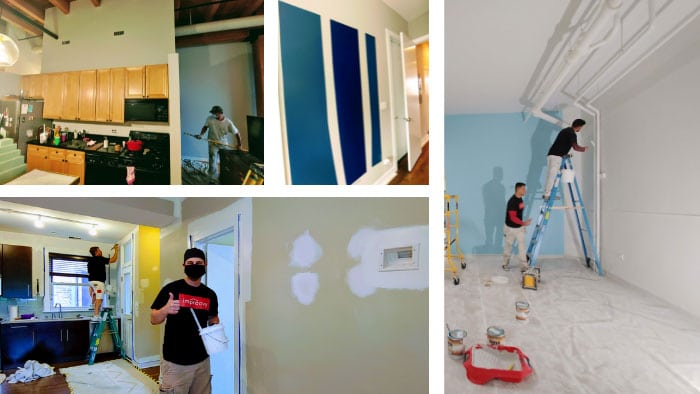Interior painting can transform the look and feel of your home, adding personality and charm to every room. Whether you’re a seasoned DIY enthusiast or a first-time painter, mastering the art of interior painting requires a combination of technique, patience, and the right tools. In this comprehensive guide, we’ll explore the best practices for interior painting, offering expert advice to help you achieve professional results. For those seeking professional assistance, consider reliable interior painting services in Auckland to bring your vision to life seamlessly.
Choosing the Right Paint
Before embarking on your painting project, it’s essential to select the right type of paint for your specific needs. With a plethora of options available in the market, including latex, oil-based, and specialty paints, understanding the differences is crucial. Consider factors such as durability, finish, and ease of application when making your decision.
Preparing the Surface
Preparing the surface is a crucial step that lays the foundation for a flawless paint job. Start by thoroughly cleaning the walls to remove dirt, grease, and other contaminants. Repair any cracks or holes using spackle or putty, and sand the surface smooth for optimal adhesion. Applying a primer ensures better coverage and helps the paint adhere evenly.
Selecting Tools and Equipment
Investing in high-quality tools and equipment can make a significant difference in the outcome of your painting project. From brushes and rollers to paint sprayers and extension poles, choose tools that match the scale and complexity of your job. Painter’s tape and drop cloths are essential for protecting surfaces and achieving clean, straight lines.
Color Selection and Coordination
Choosing the right colors can dramatically impact the ambiance and aesthetics of your space. Consider factors such as natural light, room size, and existing decor when selecting paint colors. Experiment with samples to ensure compatibility and harmony between different shades. Keep in mind the psychological effects of color and how they influence mood and perception.
Techniques for Painting
Mastering various painting techniques is essential for achieving professional-looking results. Cutting in involves using a brush to create crisp lines along edges and corners, while rolling is ideal for covering larger areas quickly. Edging and trimming require precision and attention to detail to ensure seamless transitions between colors and surfaces.
Proper Application and Coverage
Achieving proper paint application and coverage requires a delicate balance of thin coats and adequate drying time. Avoid applying thick layers of paint, which can lead to drips, streaks, and uneven coverage. Work systematically, overlapping each stroke slightly to blend the paint evenly. Be mindful of lap marks and feather edges to maintain consistency throughout.
Drying and Curing
Allowing sufficient drying and curing time is essential for the longevity and durability of your paint job. Follow manufacturer guidelines for drying times between coats, and avoid touching or recoating too soon. Curing paint fully can take several days or even weeks, depending on environmental factors such as temperature and humidity.
Clean-Up and Maintenance
Proper clean-up and maintenance are essential for preserving the beauty and integrity of your painted surfaces. Dispose of paint materials responsibly, following local regulations for hazardous waste. Regular maintenance, such as dusting and gentle cleaning, can extend the life of your paint job and keep your home looking fresh and vibrant.
Common Mistakes to Avoid
Understanding common pitfalls and mistakes can help you avoid costly errors and achieve professional results. Resist the temptation to rush through the job, and take the time to properly prepare and execute each step. Skipping prep work or using low-quality materials can compromise the longevity and quality of your paint job.
Benefits of Professional Help
While many homeowners enjoy the satisfaction of DIY projects, there are times when professional assistance is warranted. Consider hiring a professional painter for complex or large-scale projects, or when time constraints are a factor. Although professional services come at a cost, the value of expert craftsmanship and peace of mind is invaluable.
Safety Precautions
Prioritize safety throughout your painting project by taking appropriate precautions to protect yourself and others. Ensure adequate ventilation in enclosed spaces to prevent inhalation of fumes, and wear respiratory protection when necessary. Use ladders and scaffolding safely to avoid slips, falls, and other accidents.
Personalizing Spaces with Paint
Get creative and unleash your imagination by using paint to personalize your living spaces. Experiment with accent walls, bold colors, and creative techniques to make a statement and showcase your unique style. Use paint to highlight architectural features or create visual interest in bland or uninspired areas.
Final Touches and Finishing
Before calling it a day, take the time to inspect your work and make any necessary touch-ups or adjustments. Carefully remove painter’s tape to reveal clean, crisp lines, and address any imperfections or blemishes. Step back and admire your handiwork, knowing that you’ve transformed your space with skill and creativity.
Conclusion
Interior painting is both an art and a science, requiring careful planning, preparation, and execution to achieve professional results. By following these best practices and expert tips, you can elevate your painting projects and create spaces that reflect your personality and style.

